Vegan leather or artificial leather is a material that is a sustainable alternative to real leather. By definition: it is any material that mimics the look and feel of leather, but is not produced using animal hides. The material can be made in many different ways, some of which include the use of fungi, specifically the root, pineapple leaves and cactus leaves. Vegan leather has been used by multiple international brands, although there is still a debate on whether or not vegan leather is truly earth friendly. It is most often made from two different plastic polymers; polyurethane (PU) and polyvinyl chloride (PVC) – they are most commonly used due to their wrinkled texture which helps to give the effect of real leather. And it’s up for question whether vegan leather ages well just like real leather. As real leather,which over time takes on a richer complexion due to absorbing moisture and oils..

There are many types of vegan leather, from apple leather made of organic apple juice waste, bamboo leather and malai which is made from waste coconut water. It’s intriguing to see the many forms in which vegan leather has taken shape. Mushroom leather made by Bolt Threads Mylo is used by Adidas, Stella McCartney and Ganni and the roots of fungi (the mycelium) is used to make this leather alternative. Vegea or grape leather is another alternative to making vegan leather, it is made using residue of grape skins and seeds left over from wine making.
Pineapple leather is also another alternative made from the leaves of pineapples. It truly fascinates me how it is made by first harvesting the pineapples and separating the leaves. Next the fibers are removed (between 2.5% and 3.5% of a pineapple leaf is fiber) the workers decorticate the leaves hence removing the fiber using semi-automatic machines. The fibers are then dried in the sun after which the fibers are cleaned leaving a bundle of soft and downy fibers. Pinafelt, a non woven mesh, is then made by mixing the fibers with a thermoplastic derived from corn. From the Philippines, pinafelt then goes to europe where specialists color and finish it. Thus completing the cycle of the creation of vegan leather made from pineapples.

Some of vegan leather’s desirable properties is that it’s easy to work with, thin and stretchy. It is also water and stain resistant. As well as the fact that it can also be treated with different finishing treatments and dyes that alter the texture and color of the material, allowing for a wide range of versatility.
While some vegan leather is made 100% plant based there is still the issue of plant and PU hybrids as these incorporate the use of plastic in the manufacturing process. This can be seen as problematic in terms of longevity and biodegradability and there is concern over harmful microfibre shedding. There is also concern over whether they’ll sit in landfills for decades after use. Unfortunately a lot of alternative leather on the market has a synthetic finish which can crack and peel as well.

When debating on whether or not to purchase products made from vegan leather it is important to note that not all vegan leather is created equally. One must consider its raw qualities as well as the manufacturing process. As previously mentioned some vegan leather is derived from natural resources while others are constructed from synthetic elements. It is important to do your research on the composition and quality of the vegan leather products you purchase. Vegan leather is used in all sorts of things from clothing, bags and shoes to automotive interiors.

